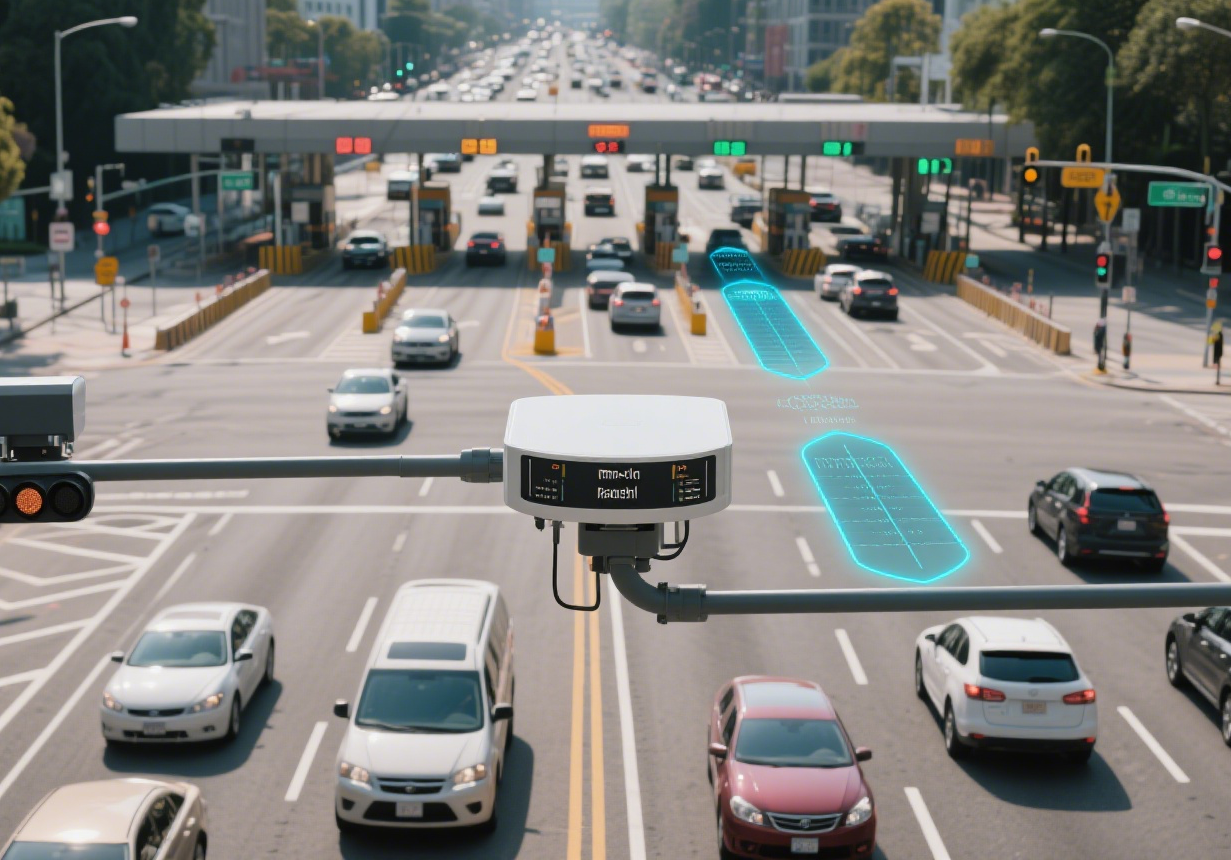As urban traffic density continues to increase, short-range, multi-lane vehicle monitoring has become a key challenge for intelligent transportation systems. Traditional cameras and low-resolution radars often struggle in these scenarios: lane mixing, occlusion, environmental interference, and short-range accuracy issues can all affect data reliability and enforcement effectiveness. Millimeter-wave (mmWave) radar, leveraging high-frequency advantages, can address these issues one by one. Below, we explain each critical point in detail.
1. Why Short-Range, Multi-Lane Monitoring Is Challenging
1.1 Lane Mixing
When vehicles travel close together in adjacent lanes, low-resolution radars often cannot distinguish them, resulting in speed or occupancy statistics being inaccurate.
1.2 Environmental Interference
Rain, fog, low-light conditions, shadows, or road reflections can reduce camera reliability. Low-end radars may also produce false alarms or miss targets due to multipath reflections.
1.3 Short-Range Accuracy
Conventional radars optimized for long distances (200m+) lose distance and speed accuracy at 20–30 meters, making lane-by-lane distinction difficult.
2. How mmWave Radar Solves These Issues
2.1 High-Precision Range Resolution
mmWave radars use 76–81 GHz FMCW signals with bandwidth typically 4–5 GHz, achieving centimeter-level range accuracy.
-
Detailed explanation: With a 4 GHz bandwidth, range resolution is approximately 3.75 cm, allowing vehicles roughly 4 meters long to be distinctly separated and preventing overlap in measurement.
-
Practical tip: Engineers can adjust radar bandwidth according to lane width and target distance to optimize short-range multi-target separation.
2.2 Fine Angular Resolution
Using MIMO antenna arrays, mmWave radars form narrow beams with angular resolution as low as 2–3°.
-
Explanation: Each lane can be mapped to a radar angle coordinate, enabling clear separation of vehicles even when lanes are only 3 meters apart.
-
Implementation tip: Increasing the number of antenna channels further improves resolution for dense traffic environments.
2.3 Doppler Velocity Measurement
mmWave radars measure speed directly via the Doppler effect, avoiding errors caused by occlusion or lighting conditions that affect video-based speed calculation.
-
Detailed explanation: Even tightly parallel vehicles generate independent velocity readings.
-
Application: Speed thresholds can distinguish stationary, slow, and fast vehicles, aiding traffic signal optimization and violation detection.
2.4 ROI (Region of Interest) Configuration
Each lane can have a dedicated ROI, ensuring the radar only detects within the designated area and preventing cross-lane interference.
-
Explanation: ROIs can be polygonal or gridded, precisely covering lanes and excluding pedestrian or obstacle areas.
-
Optimization: Adjust ROI boundaries using initial point cloud data and field measurements to prevent missed or false detections.
3. Practical Applications
3.1 Urban Intersections
-
Challenge: Multiple lanes, tightly spaced vehicles, buses or large trucks occluding smaller cars.
-
Advantage: Lane-by-lane tracking provides reliable occupancy and speed data for adaptive traffic lights.
-
Deployment tip: Slight downward tilt of 10–15° reduces ground and barrier reflection interference.
3.2 Toll Stations and Highway Ramps
-
Challenge: Vehicles with varying speeds and sizes.
-
Advantage: High-resolution radar enables multi-lane classification and accurate speed measurement, avoiding low-speed vehicles being mixed into high-speed data.
-
Implementation: Assign individual speed thresholds and occupancy logic for each lane ROI.
3.3 Intelligent Traffic Enforcement
-
Challenge: Continuous, all-weather monitoring, detecting violations across lanes.
-
Advantage: Radar identifies vehicles using combined Doppler and angle information, supporting enforcement and data analysis.
4. Installation & Deployment Recommendations
-
Mounting height: 2.5–3.5 meters, depending on lane width and number of lanes.
-
Tilt angle: 10–15° downward to reduce ground clutter.
-
Beam configuration: Adjust horizontal FOV to cover each lane independently.
-
ROI calibration: Use point cloud data and real vehicle trajectories to ensure complete lane coverage without overlap.
-
Data output: Supports RS485, CAN, or Ethernet interfaces to ITS systems, providing per-lane speed and occupancy information.
5. FAQ (Frequently Asked Questions)
Q1: Can mmWave radar operate in rain or fog?
A1: Yes. mmWave radar has strong penetration through rain and fog, providing more stable performance than cameras or optical sensors.
Q2: Will vehicles in adjacent lanes be mixed?
A2: High angular resolution combined with ROI configuration effectively separates vehicles in neighboring lanes.
Q3: What lane widths are suitable for radar deployment?
A3: Standard lanes of 3–4 meters work well per ROI; wider lanes can be divided into multiple ROIs or beam configurations adjusted.
Q4: How is short-range accuracy ensured?
A4: By tuning bandwidth, CFAR thresholds, frame integration, and optimizing installation angles and antenna layout, detection at 20–50 meters remains accurate.
Q5: How does the radar integrate with existing ITS systems?
A5: It supports RS485, CAN, or Ethernet outputs, directly providing lane-specific speed, occupancy, and classification data to traffic management systems.
6. Deployment Considerations
-
Number of antennas and radars: For multiple lanes, a multi-unit array may be needed to ensure independent detection for each lane.
-
Placement: Prefer poles at intersections, toll stations, or ramp sides for unobstructed views.
-
ROI setup: Use initial point cloud and field measurements to calibrate ROI boundaries accurately.
-
System tuning: Adjust CFAR parameters and multi-target tracking algorithms according to traffic speed and density to minimize false alarms and missed detections.
-
Maintenance: Although radar is robust in all weather, regular inspection of antennas and signal processing units ensures long-term reliability.
7. Conclusion
Millimeter-wave radar, with high-precision range, fine angular resolution, Doppler speed measurement, and precise ROI configuration, effectively solves short-range, multi-lane monitoring challenges.
In urban intersections, toll stations, and intelligent traffic enforcement scenarios, mmWave radar provides reliable data that supports traffic management, enforcement, and flow analysis.
By combining proper mounting height, tilt angle, beam configuration, and ROI calibration, radar performance can be fully leveraged to achieve per-lane, all-weather, high-precision traffic monitoring.
👉 Learn more about Linpowave radar solutions: Linpowave V200 Radar



